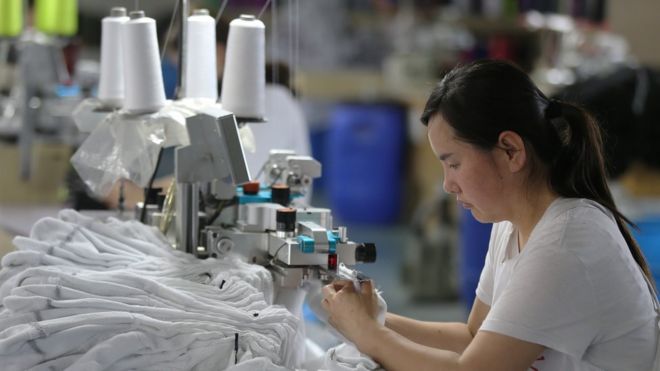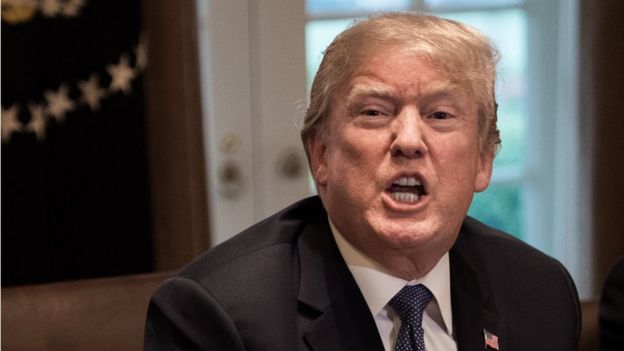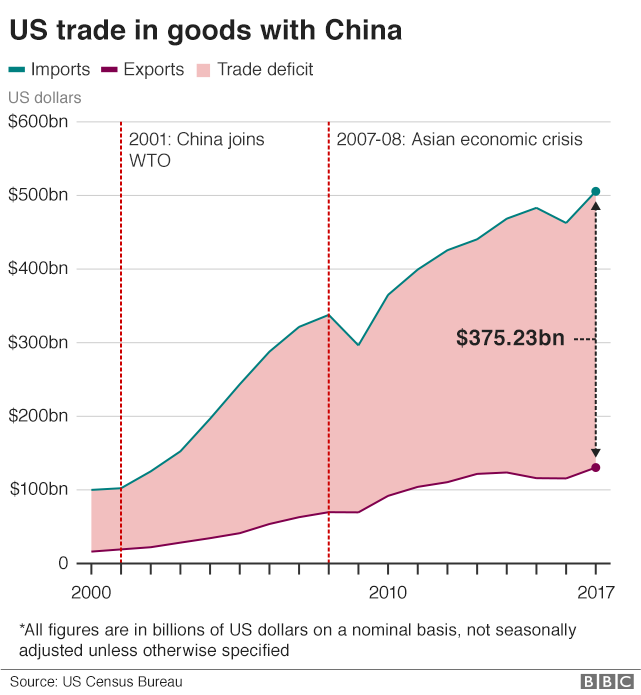
US President Donald Trump's trade war against China has moved up a gear as it brings in a 25% tax on a second wave of goods worth $16bn (£12.4bn).
The move ratchets up the dispute which began in July. The US imports far more goods from China than it exports to it.
There are fears that more tariffs could cause further damage to companies and consumers. Goods affected this time include motorcycles and aerials.
China immediately imposed retaliatory taxes on the same value of US products.
Why did this start?
President Trump has been sounding off about unfair trade since even before he became president.
During the 2016 election campaign, he said China engaged in the "rape" of the American economy.
He ordered an investigation into Chinese trade policies in August 2017 and has been steadily imposing tariffs on Chinese goods since January this year.
- Bikes, cots and fridges: the imports hit by Trump's tariffs
- US-China trade row: What has happened so far?
- The early victims of Trump's trade war
- Six ways China could retaliate in a trade war
His assertion is that China - and other countries - are taking advantage of US companies by selling their goods too cheaply.
In China, low production costs and a weak currency keep prices competitive. As a result, US imports from China far exceed the amount of goods going in the other direction.
President Trump thinks that by slapping on an extra tax - or tariff - he will make life easier for US companies, whose goods will become cheaper within the US by comparison.
As well as China, Mr Trump's "America First" policies have seen taxes imposed on Mexico, Canada and the European Union, to encourage consumers to buy American products. All of those countries have retaliated.

President Trump has taken an aggressive stance on trade with China
What goods are involved?
The US has applied new tariffs to a vast range of goods in 279 product categories,including children's cots and bedding, animal medicines, semiconductors, plastics, chemicals and railway equipment, shrimps and shrimp products, handbags and fridges.
China's list of 333 US product categories includes coal, copper scrap, fuel, buses and medical equipment.
Previous items affected included steel, soya beans, fruit, wine, whiskey, the famous Harley Davidson motor bikes and pig products.
What effect are his actions having in the US?
Although Mr Trump states his moves are aimed at protecting US industry and business, dozens of US companies and industry groups have testified to the US Trade Representative's Office that their businesses are being harmed.
Major carmakers recently warned that changes to trade policies were hurting performance.
Demand for their goods in China has fallen as US products are made more expensive by the addition of tariffs - after all, that is tariffs are designed to do.
And there are even warnings that the tariff on children's cots could be harmful to health. "Increasing tariffs on juvenile bedding products would directly promote an increased risk to child safety," claims Sam Shamie, of the Delta Enterprise Corporation.
Kenneth O'Brien of Gemini Shippers Group is particularly vocal in his opposition to tariffs on Chinese imports, which he says "will lead to the destruction of American jobs and the potential bankruptcy of US small businesses".
And as well as making Chinese goods more expensive for US consumers, the price of some US goods may rise, too.
Many of the businesses whose products have had retaliation tariffs applied warn they would not be able to absorb another tax without raising prices for US consumers.
Some businesses welcome the move, though.
The Southern Shrimp Alliance is glad not to have to compete with Chinese shrimp products. It also says these are a health risk to the American public, so there's an additional benefit to the tariffs here.
And what about in China?
China blames the US and has accused it of "unilaterally" heightening tensions between the two economic giants.
The main difference is that Chinese goods are very widely bought in the US indeed, as they are in the rest of the world. Not for nothing is China sometimes called the world's workshop.
The list of US goods taxed in China is typically a higher-end luxury one, whose products are already expensive and less essential.
The range of goods available for China to put retaliatory taxes on is therefore shorter, lessening the immediate impact.
But there are other ways that China can respond. Iris Pang, Greater China economist at ING Wholesale Banking in Hong Kong, says it could make life harder for the US to do business in China, by increasing the cost and amount of red tape.
And the rest of the world?
As the BBC's South Asian business editor, Karishma Vaswani, points out, what hurts Beijing can also hurt countries further afield.
Many goods that are needed for final assembly in China actually come from other South East Asian countries such as Malaysia and Indonesia, and go through Singapore to have some other products added on.
The International Monetary Fund said last month an escalation of the tit-for-tat tariffs could shave 0.5% off global growth by 2020.
Economists say that means some countries in the Asia-Pacific region could see as much as a percentage point shaved off economic growth.
But, she says, if this trade war continues, the outlook could be far more grim.



What are the next steps?
Officials from the US and China are currently holding low-level talks in Washington, but hopes are not high that they will bring the dispute to an end.
The US has threatened a third round of tariffs on an additional $200bn of Chinese goods. These could come as soon as next month.
It has since said those products could be hit with a 25% levy - more than double the 10% originally planned.
China has said it would respond with another tariff on $60bn of US goods.
Meantime, China plans to file a fresh complaint against the tariffs at the World Trade Organization (WTO), which adjudicates in global trade disputes.
China's commerce ministry says it "clearly suspected" the US of violating WTO rules.
It filed an initial complaint at the WTO in July as Mr Trump imposed his first round of tariffs.
Ultimately, all exports from China to the US could face tariffs. The president said in July that he was ready to tax all of the $500bn worth of Chinese imports into the US.
China has retaliated in kind to both hostilities from the US and there's no reason to think it would not respond in the same "toe-to-toe" fashion.
No comments:
Post a Comment